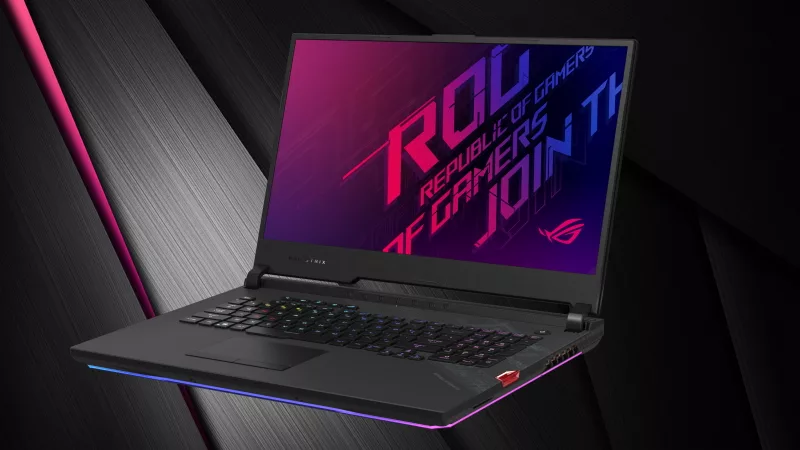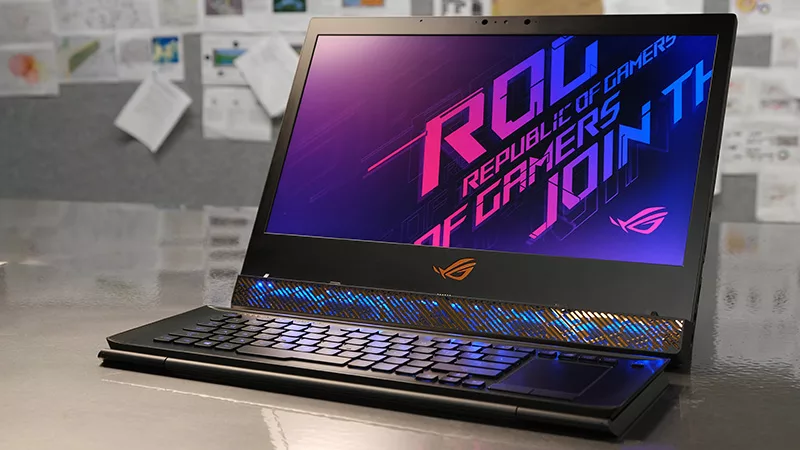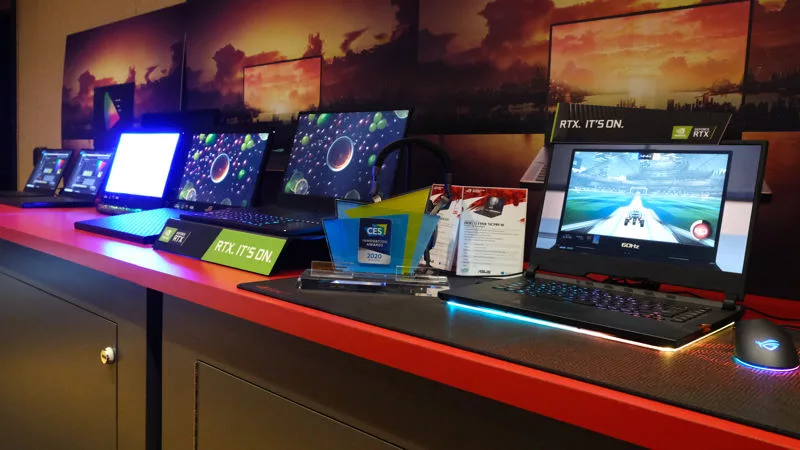Basking in the glory of 240Hz gaming with the ROG Strix SCAR III
Some laptops try to be all things to all people. Others are purpose-built to specialize. The ROG Strix SCAR III boasts some of the most potent laptop hardware around, so it’s good for most any demanding task. But thanks to its optional 240Hz display, it’s especially well suited to aspiring and established esports athletes who depend on high frame rates to fuel their lightning-fast reflexes. If you haven't hoisted an esports trophy, though, worry not. The SCAR III is great for those who play the latest first-person shooters, VR pioneers, and fans of the frenetic real-time strategy genre.
After spending a few weeks with the ROG Strix SCAR III G531GW, playing everything from Battlefield V with ray-traced reflections cranked up to Overwatch at over 200 FPS, I can decisively say this is one of the most satisfying gaming PCs I’ve ever used.
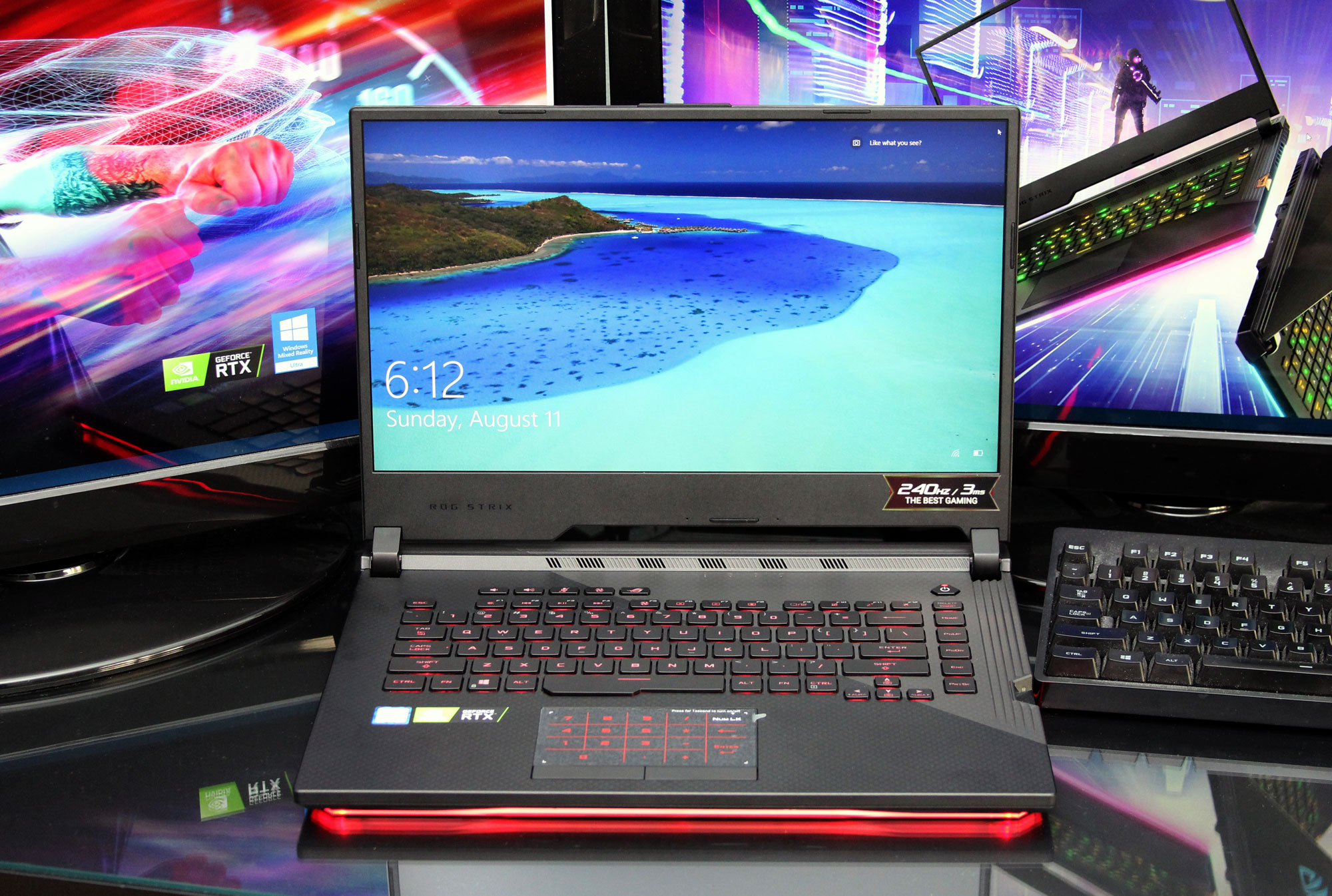
The Strix SCAR III sports a killer spec sheet tailor-made to showcase its 240Hz IPS-level display. Ninth-generation Intel Core CPUs offer the highest single-threaded performance available so that processor-bound games run as fast as possible. NVIDIA’s Turing-based GPUs feature real-time ray tracing acceleration for the next generation of ultra-realistic games, plus optimizations to speed up fast-paced classics. And a whopping 1TB of PCIe-attached solid-state storage tears through level load times to get you into the action more quickly.
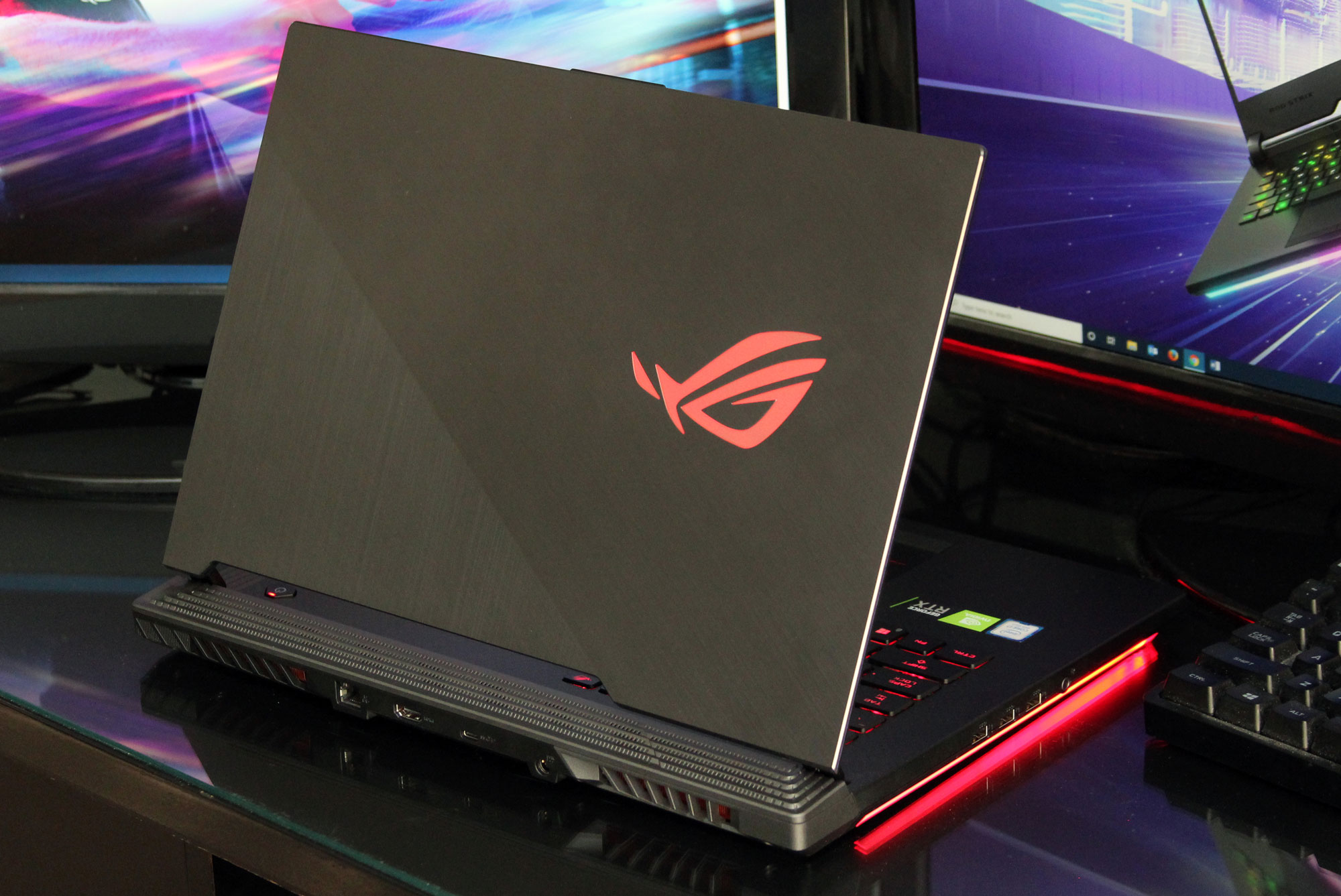
Our engineers built a beautiful chassis around all those components using brushed metal, carbon fiber-patterned surfaces, and generous doses of Aura RGB LED lighting. But the design isn’t just meant to look good. Ridges along the laptop’s back side camouflage an array of perforations that feed a powerful cooler, while strategic venting around the WASD keys keeps the keyboard comfortable to use during extended gaming sessions.
This beast is a beauty
It isn’t easy to pack the fastest mobile hardware into a notebook measuring just 360mm wide, 275mm deep, and 24.9mm tall. But our engineers built a functional exterior with provisions for copious intake, unrestricted exhaust, well-placed I/O, and attractive styling. They proceeded to carve out an interior where every vent, fan, and light has its place.
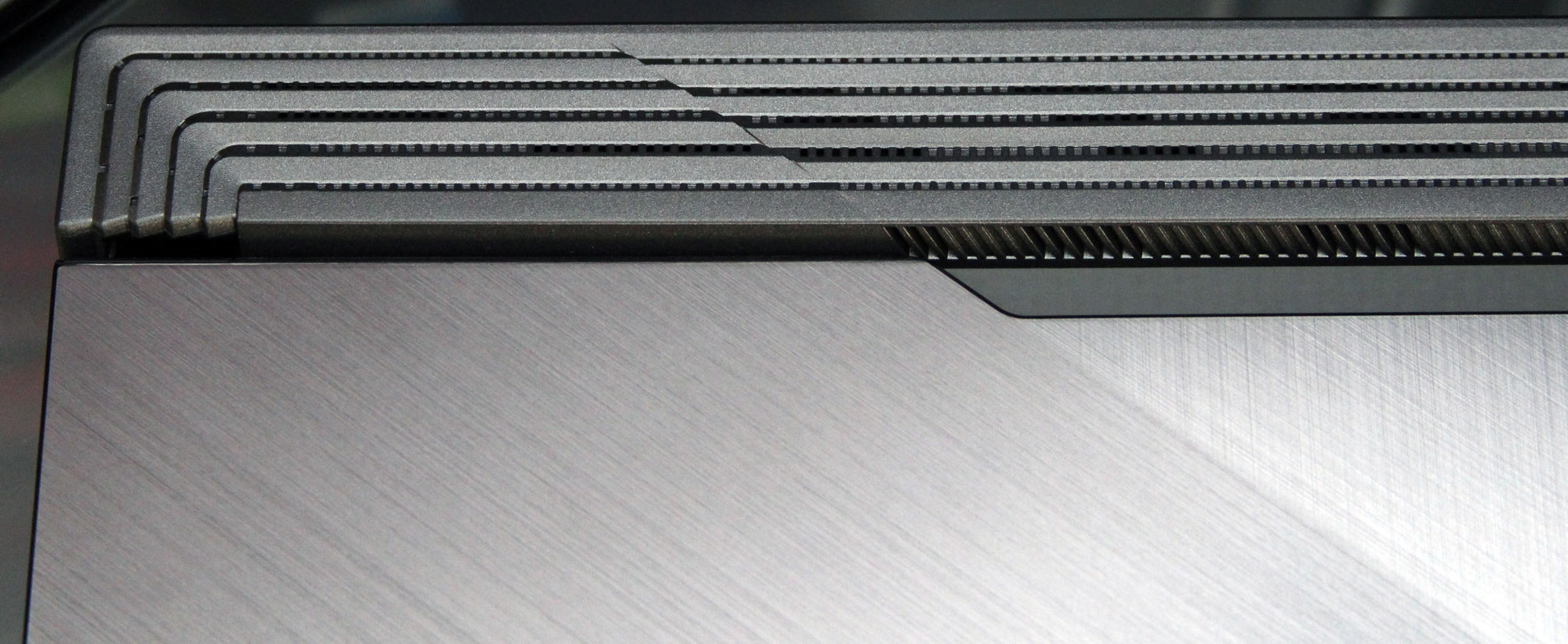
One of the most apparent examples of their efforts is the set of raised ridges along the SCAR III’s top edge. More than just an aesthetic statement, each trough is peppered with vents that the cooling subsystem draws fresh air through. Opening the laptop’s lid puts its 15.6” display directly over those intakes, so our designers notched out space along the bottom edge of the screen to make room for freer flow. This touch isn't just functional; it adds an eye-catching asymmetry to the bottom edge of the lid.
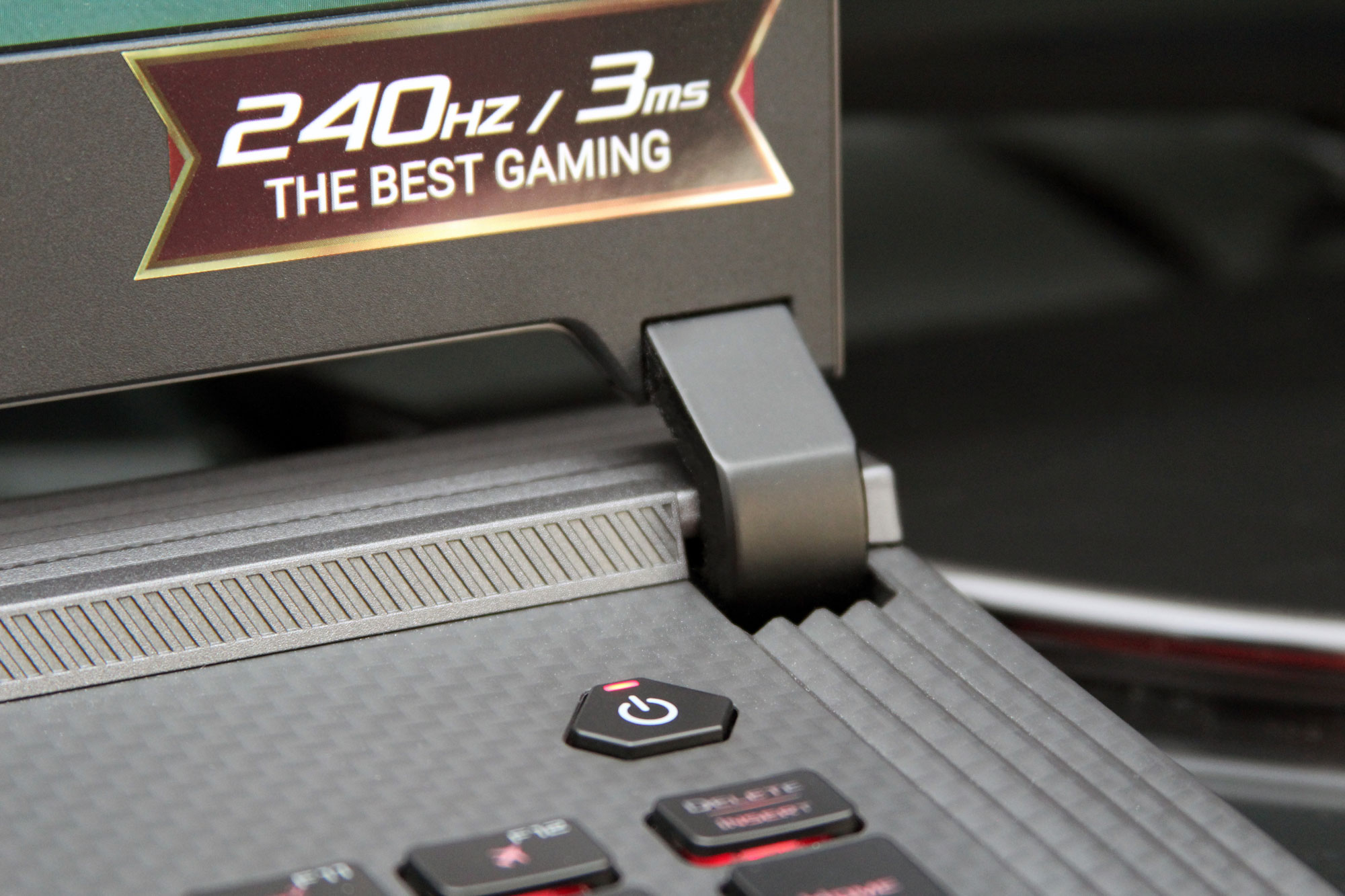
As I swung the lid up and open, I was especially enamored with the thin display’s rigidity and how well both hinges held the panel in place. Those hinges were inspired by the gullwing doors made notable by cars like the Mercedes-Benz 300SL, the DeLorean DMC-12, and Tesla’s Model X. They emerge from inside the chassis in one fluid motion and, once set in place, allow very little flex. It’s a confidence-inspiring touch. When you’re ready to pack up and move, they slide back in smoothly, protecting against damage on the road.
I was also impressed at how easy it was to gain access to the laptop’s innards, simplifying upgrades for enthusiasts. The bottom panel is attached to the frame with 11 standard screws, so you don’t need special equipment to get in there. Simply loosen the screws and tug up on the panel to reveal the platform underneath. My SCAR III has a 1TB M.2 SSD and 16GB of DDR4-2666 installed across two memory slots, but I could have added a 2.5” storage device or replaced the memory modules to hit the notebook’s 32GB ceiling.

An LED light bar wraps around the SCAR III’s front and sides. You can choose from a large number of effects, including a celebratory ASUS 30th anniversary light show that sparkles and shines before spelling out “30” on the keyboard. My personal favorite is a static red, which looks downright ominous glowing from underneath the laptop, across its keys, and through the lid’s ROG logo. When I wanted to keep a lower profile, I simply activated the Dark mode in Armoury Crate’s Aura Effects menu, shutting off all the lighting.

Even without the RGB LEDs active, the Strix SCAR III is an eye-catcher. When it’s closed, you’ll be drawn to a metal lid that's brushed in two directions for a contrast that almost conveys a bit of depth. With the lid open, a two-tone carbon-fiber surface surrounding the keyboard and trackpad echoes the brushed lid. It’s both smooth and highly resistant to finger oils, so you won’t have to worry about cleaning off ugly streaks after playing your favorite shooter all night. Ridges that look a lot like those in the back run up the right-hand side of the keyboard deck, calling attention to a cut-out in the chassis.
Step up to a 240Hz display for ultra-responsive gaming
Professional gamers need every advantage they can get. Part of their edge comes from potent multi-core CPUs and graphics processors able to crank out smooth frame rates. But it does little good for a GPU to render 200 frames every second if your monitor can only update what you see on-screen 60 times within the same interval. Displays with higher refresh rates are a necessity in competitive circles. They minimize perceived blur during twitchy action. They cut down on screen tearing. And because a smaller refresh interval keeps the action fresher, you have the unique opportunity to react more quickly compared to competitors on 60Hz screens.
True to its purpose, the ROG Strix SCAR III can be configured with either 144Hz or 240Hz IPS-class panels. Both displays feature native resolutions of 1920x1080, 3ms pixel response times, and 100% coverage of the sRGB gamut for accurate color reproduction. The laptop I tested came equipped with the flagship 240Hz panel. I’m no professional gamer, so I was initially concerned I wouldn’t be able to discern the benefit of a 240Hz refresh rate. But even just toggling between 60Hz and 240Hz from within Windows made the difference in smoothness immediately obvious. After years at 60Hz, I’m accustomed to a tail following the mouse cursor across my desktop system’s three screens. Refreshing at 240Hz eliminates that tail no matter how fast you flick the cursor around.
I fired up games like Fortnite, Overwatch, and Destiny 2 to see if the same effect carried over to 3D applications. Sure enough, each one felt so much more fluid at 240Hz compared to 60Hz, even at the same resolution and quality settings. The improvement was blatant, to the point that switching back to 60Hz actually made the GeForce RTX 2070 seem slower.
Just like a new pair of Jordans isn’t going to get you a spot in the NBA, a 240Hz refresh rate won’t magically up your kill/death ratio. However, I can see how a high refresh rate is imperative for the professionals who need every millisecond possible to get a shot off before their competition. For the rest of us, 120Hz and 240Hz panels paired with capable GPUs make on-screen action crisper. That’s a benefit we can all enjoy.
Desktop specs in a mobile form factor
Fast displays are only as useful as the graphics subsystems driving them. To that end, the ROG Strix SCAR III includes NVIDIA’s GeForce RTX 2070, RTX 2060, or GTX 1660 Ti graphics processors. All three options are based on NVIDIA's latest Turing architecture. Turing incorporates a myriad of enhancements to extract more performance from each watt of power consumed. Both RTX models also sport on-die resources to accelerate real-time ray tracing and the matrix multiplication operations inherent to AI workloads. Popular titles like Battlefield V, Metro Exodus, Shadow of the Tomb Raider, and Wolfenstein: Youngblood already incorporate ray tracing to augment realism. I’m also looking forward to seeing how Call of Duty: Modern Warfare and Cyberpunk 2077 use ray tracing to enhance their stories.
I was excited to see that the SCAR III G531GW model that I tested came with a GeForce RTX 2070 to complement its 240Hz panel. Based on a 13.6-billion-transistor TU104 processor, the GeForce RTX 2070 has no trouble driving playable frame rates on 4K monitors, so I knew it’d be an absolute beast paired up with a Full HD display.
Each mobile graphics processor available with the SCAR III is based on the same GPU NVIDIA uses in its desktop cards. These chips' core counts, L3 cache sizes, memory buses, and generous helpings of GDDR6 all match. The chips are only limited by power consumption, which caps their peak clock rates. And the ROG Boost design philosophy ensures that laptops with this treatment feed their GPUs with every watt they can handle.
Because no two laptops are alike, a given chip in the GeForce RTX mobile family can be tuned to run within a range of power envelopes, something you'll typically see expressed on spec sheets as a figure like 80W or 115W. Thinner and lighter laptops tend to have less effective cooling systems than big and chunky ones, so system designers might have to dial back the power delivered to the GPU to keep heat and noise in check. That design choice doesn't just affect heat and noise production, though. It can result in lower clocks and less delivered performance. Even if you're comparing one GeForce RTX 2070 notebook to another, there's more to the story than the graphics chip on the spec sheet.
When you see the ROG Boost treatment on one of our laptops, you can rest assured that you're getting the highest-power, highest-performance version of a given mobile graphics processor in your notebook. Despite the potential cooling challenges we noted above, even some of our thinnest and lightest gaming notebooks benefit from ROG Boost, like the Zephyrus S GX502. The SCAR III isn't as razor-thin as the GX502, but ROG Boost still ensures that the SCAR III delivers all of the graphics performance the RTX 2070 can potentially bring to bear—and potentially even more. Fire up the Turbo mode in Armoury Crate for the SCAR III, and you could see as much as a 100MHz bump over the mobile RTX 2070's specified boost clock speed.
To figure out just what ROG Boost and the GeForce RTX 2070 can do for games, I ran the SCAR III through my standard test suite. This gauntlet uses a blend of AAA games and fast-paced esports titles to showcase the full range of performance from a system.
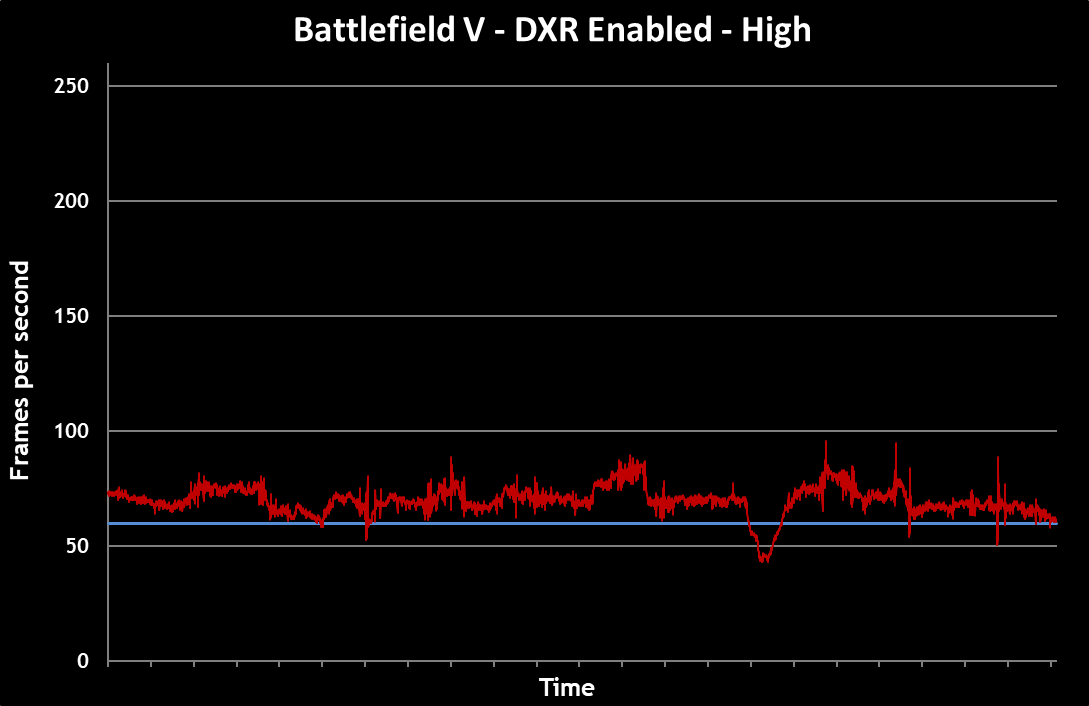
My most punishing benchmark involved firing up Battlefield V, cranking the game’s quality preset up to High, and enabling real-time ray tracing. This is a taxing test even on well-appointed desktop PCs. But the ROG Strix SCAR III averaged a perfectly smooth 70 frames per second. It only dipped below 50 FPS once during a sequence where multiple fuel drums explode and cause fiery reflections on all the surrounding surfaces.
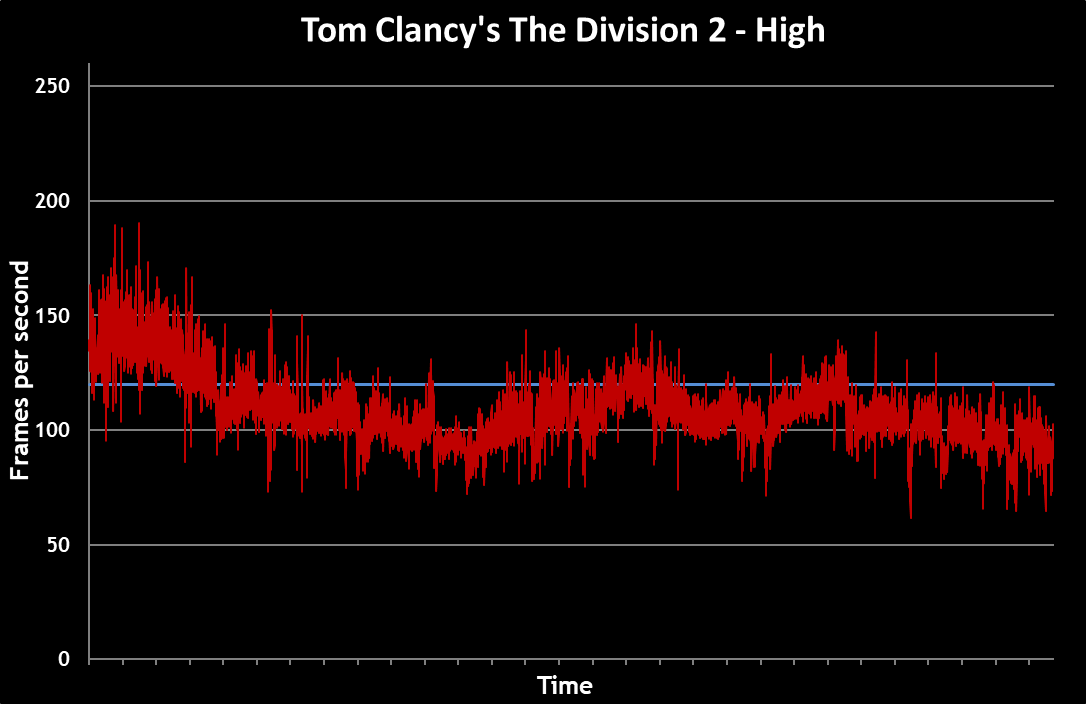
Tom Clancy’s The Division 2 also uses a DirectX 12 game engine. It doesn’t harness the DirectX Raytracing API, though, so performance is higher through my benchmark. An average of 111 FPS covers peaks of up to 190 FPS and dips down to 62 FPS. Throughout that range, you’re enjoying the benefits of a high-end GPU and a display able to refresh at 144Hz or 240Hz.
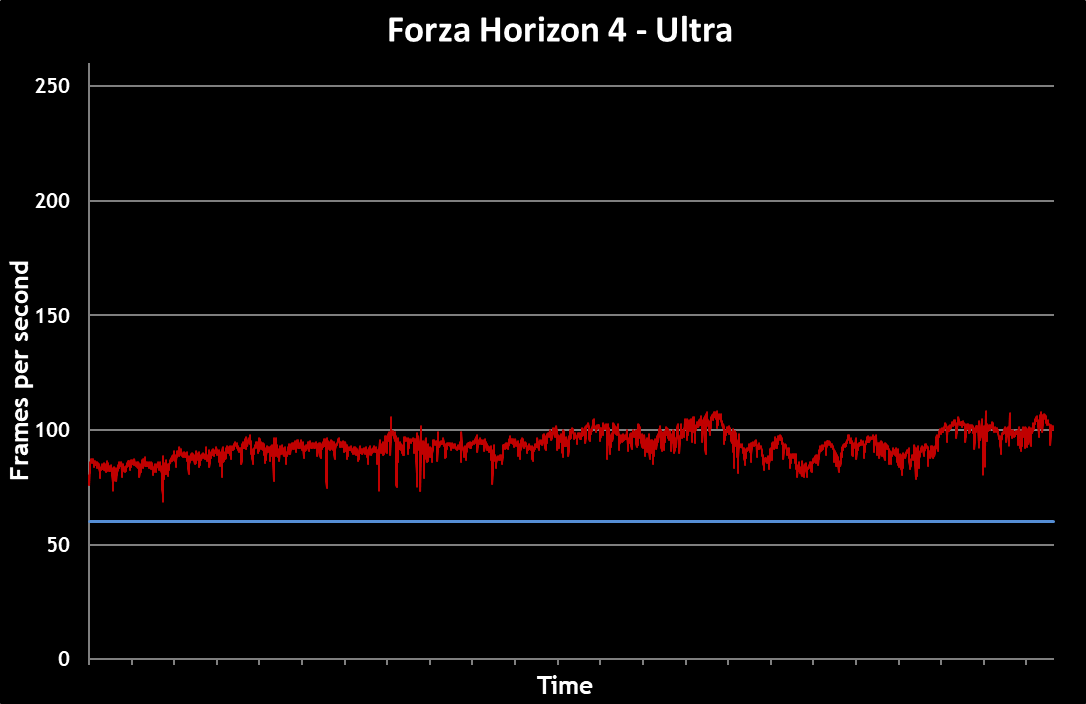
Smooth animation is a boon in racing simulators like Forza Horizon 4, too. Evenly-paced animation makes frame time spikes painfully obvious, so the priority is on fluidity rather than absolute frame rates. The Strix SCAR III I tested nevertheless offers both with aplomb. Averaging 93 FPS at 1920x1080 using the game’s most taxing Ultra preset, the lowest frames came in at roughly 70 FPS. It’d be hard to ask for more.
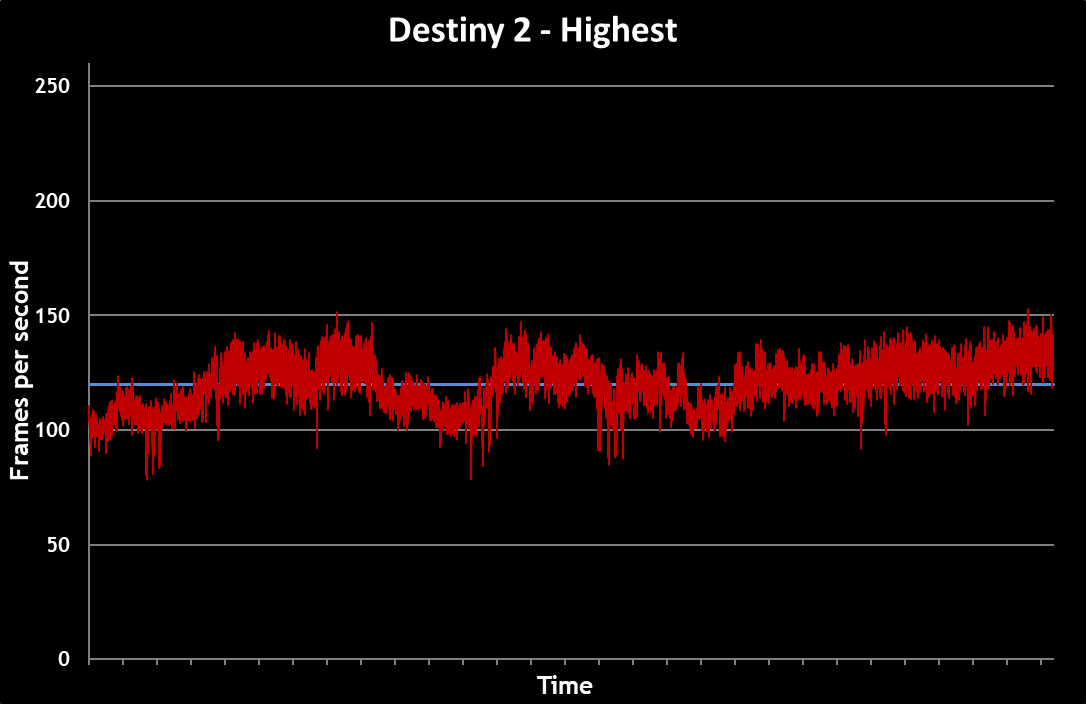
Destiny 2 doesn’t impose the same demanding graphics seen in Battlefield V and The Division 2. As such, we’re able to dial in its top quality setting and still average more than 120 FPS. Peaks in excess of 150 FPS go beyond what a 144Hz panel can display, so you’d either want to cap the game’s frame rate or step up to the 240Hz LCD.
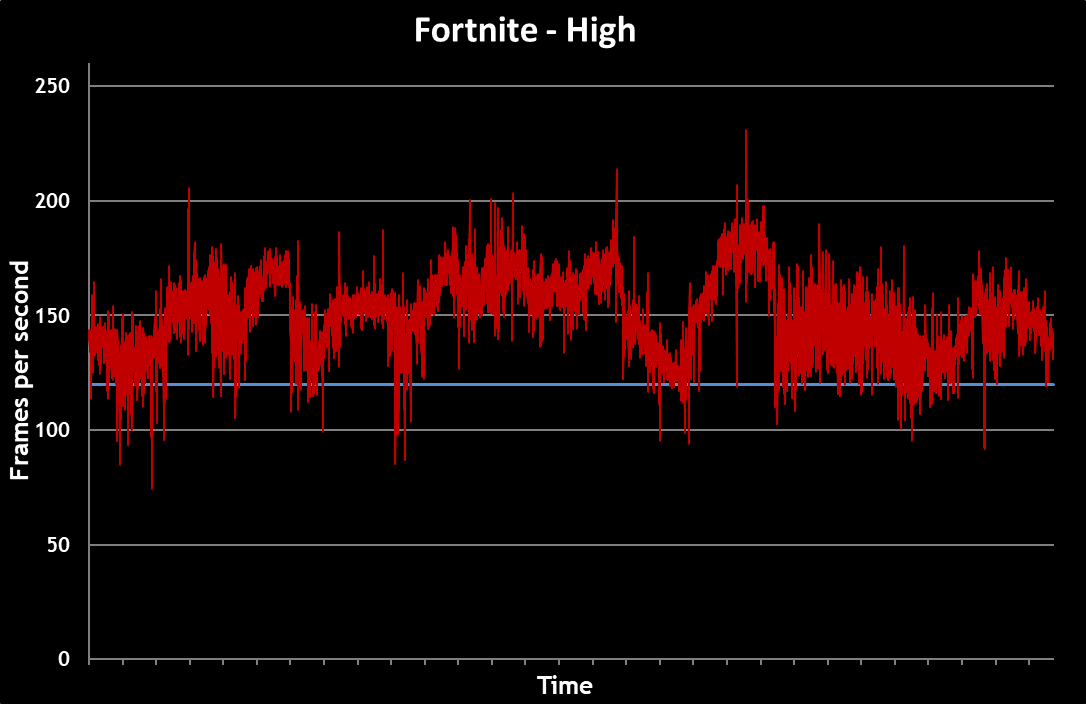
Now we’re into the games that beg for triple-digit frame rates and high-refresh screens. Fortnite may dip to 75 FPS on occasion, but it also hits 230 FPS peaks. A 150 FPS average makes us glad for our test sample’s 240Hz refresh rate.
The Scar III has headroom to dial in higher quality settings in Fortnite, to be sure. The High preset looks good enough, though, and professional gamers prefer consistent frame delivery to eye candy.
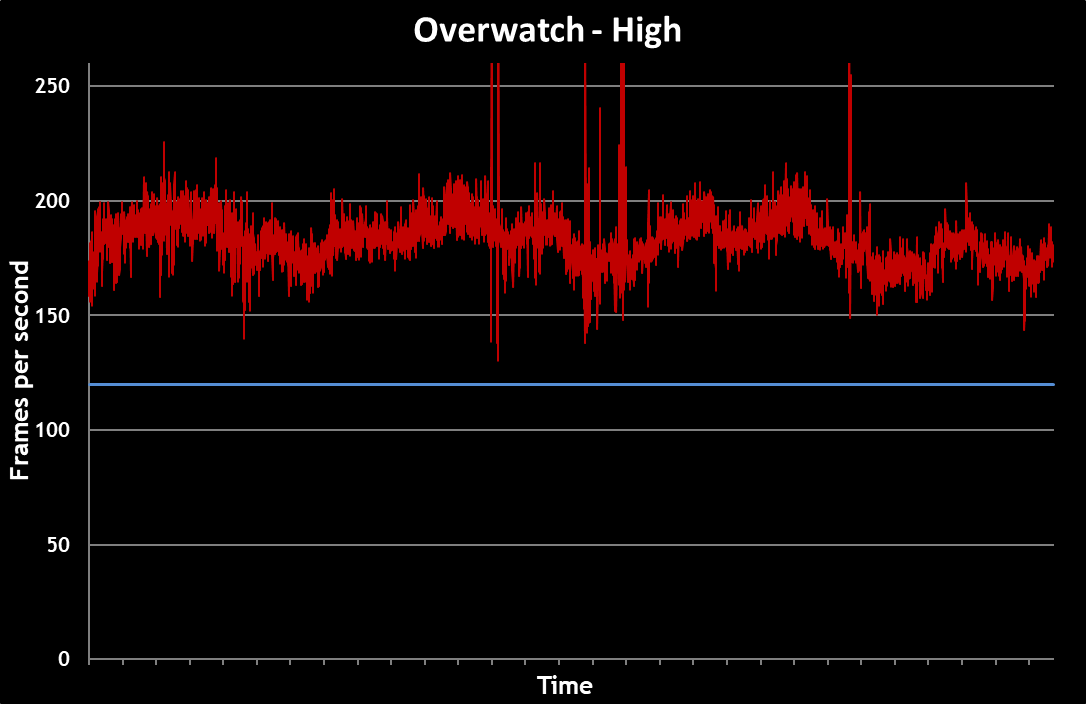
Frame rates as high as 260 FPS in Overwatch blow past the SCAR III’s 240Hz refresh rate, illustrating two things: first, high-end laptop hardware is entirely capable of driving the kind of performance competitive gamers want to see, and second, there’s a very real reason to want a panel that refreshes faster than 144Hz.
The only way NVIDIA’s GeForce RTX 2070 can deliver such impressive frame rates is on the back of a well-balanced platform. My SCAR III G531GW was armed with an Intel Core i7-9750H CPU. This chip boasts six Hyper-Threaded cores able to operate on 12 threads concurrently. Its 2.6GHz base frequency is but a floor; under more demanding gaming workloads, it’s common to see the chip operating at over 4GHz. And in single-threaded tasks, it boosts to a maximum of 4.5GHz. Two other CPU options—a Core i9-9880H and a Core i5-9300H—offer eight and four Hyper-Threaded cores, respectively. They similarly boost beyond 4GHz inside of a 45W power budget and are wholly capable of keeping NVIDIA’s GPU busy.
Regardless of the CPU model you choose, every SCAR III configuration uses an Intel HM370 platform hosting two memory slots to populate the ninth-gen Core architecture’s dual-channel memory bus. My test rig came with two 8GB modules of DDR4-2666, totaling 16GB. But you can arm the system with up to 32GB if you’re gaming and streaming or recording gameplay for editing later.
Solid-state storage is naturally a must for quick level load times. The 1TB M.2 NVMe SSD in my G531GW was roomy enough to house my entire test suite with 500GB left over. You'll find a SATA adapter in the box, as well, making it possible to populate the laptop’s vacant 2.5” bay with another SSD.
It takes Intelligent Cooling to make this magic happen
The hardware needed to sustain triple-digit frame rates doesn’t just slide into a 15.6” laptop form factor without serious forethought. We make the most of the SCAR III’s diminutive chassis by drawing waste heat away from the CPU and GPU as quickly as possible, then dissipating that thermal energy out across dense arrays of copper fins before exhausting it from vents on the back and side.
Ample airflow is the first tenet of any effective cooler. The Strix SCAR III employs what we refer to as a 3D Flow Zone to open up plenty of room for intake and exhaust. Cool air is drawn in through those perforated ridges along the back. A trapezoidal cut in the display’s bottom bezel minimizes obstruction over top of these ridges, and the fans underneath can consequently breathe more deeply. Forward-facing hinges are tucked up inside the chassis to make room for a pair of sinks facing back and away. Those heat sinks, plus a third on the laptop’s right side, are composed of copper fins as slim as 0.1mm. Depending on your CPU and GPU configuration, there might be as many as 189 fins totaling up to 102,500mm² of surface area.
A twisting maze of five flattened pipes connect the sinks to plates sitting right on top of the SCAR III’s two hottest components. Some of the pipes are dedicated to one chip or the other. A single pipe touches them both. And another pipe helps cool the GPU’s adjacent GDDR6 memory modules and voltage regulation circuitry.
With its bottom panel removed, the SCAR III’s two n-Blade fans stand out prominently. These fans are unique for their dense array of 83 blades, made of a liquid-crystal polymer designed to hold its shape at high speeds. Air is pulled into the 12V fans and blown past a special self-cleaning channel that keeps contaminants from affecting the cooling system’s efficiency over time.
Ample heatsink hardware is just the foundation of a full-stack cooling solution, though. The ROG Intelligent Cooling approach melds hardware and software to deliver the best balance of performance and cooling depending on the task at hand.
Our first software optimization, Operating Modes, let you choose among Silent, Performance, and Turbo modes in the Armoury Crate utility to optimize the performance and noise production of your system for your performance needs and your surrounding environment. For example, you might not want your notebook's fans to spin up during class, in a library, or in a coffee shop. Silent mode avoids that disturbance by running the notebook at a low power level that we've pre-configured to hit a low noise target.
At the opposite end of the spectrum, you might need every bit of CPU and graphics power you can get to render out a video or a 3D rendering project to hit a class or client deadline. You don't care how much noise the system makes to get there. Turbo mode maximizes power delivery to system components and cranks the cooling system so that you can tap into every bit of the performance your system can offer. Performance mode strikes a balance between those two extremes for healthy performance at ear-friendly sound pressure levels.
Many notebook enthusiasts will be familiar with switching among Operating Modes manually, but we've gone a step further with Intelligent Cooling. We've given Armoury Crate the ability to manage performance and cooling automatically through the use of Scenario Profiles. Scenario Profiles encompass not just the Operating Mode, but a range of settings including the Aura Sync lighting effect, whether the Windows key, ROG key, and touchpad are active; the GameVisual display mode and Sonic Studio mode, and more. Once you've defined a Scenario Profile, you can associate it with a given game or application. Armoury Crate constantly monitors which application is in the foreground and switches among Scenario Profiles automatically depending on the profile you've linked to the task in question.
Turning heads with Aura Sync
RGB LEDs figure prominently into the Strix SCAR III’s design thanks to a wrap-around light bar, per-key lighting, and the lid’s glowing ROG logo. When you’re done setting up performance profiles in Armoury Crate, click down to the menu’s Aura icon and select the Aura Effects tab. My build of the software gave me a choice between 10 different Basic Effects, including one called Dark for disabling all lighting. If you want to get really fancy, fire up Aura Creator and configure your lighting on a per-key or per-zone basis with custom effect timing and colors. Each side and corner of the light bar can be tweaked independently, as can the lid’s ROG logo.

Aura Sync support means that your Aura-capable headset and mouse can join in on the fun. Tab back over to Sync Devices and select any compatible peripherals you want synchronized to the Strix SCAR III, then tab back to Aura Effects and adjust the whole setup under Basic Effects. Or fire up Aura Creator again. The utility lets you rearrange each piece of hardware in virtual space so that the Rainbow effect transitions smoothly from your keyboard to mouse. Detail-oriented gamers can hone their timings for a truly one-of-a-kind presentation.
Unfettered network performance by land and air
I’m a big fan of playing through well-directed campaigns, and I enjoyed getting a first taste of Wolfenstein: Youngblood on the SCAR III’s beastly GeForce RTX 2070. But professional gamers don’t gain notoriety for holing up in their rooms and fragging solo. A laptop like the G531GW I tested yearns for multi-player participation. We oblige with a Realtek Gigabit Ethernet controller attached via PCI Express. When I’m in range of a wired connection, that’s what I use for low-latency gaming.
But there’s also an Intel Wireless-AC 9560 card under the hood. We hook up two transmit and two receive antennas to reach data rates as high as 1.7 Gb/s. Our RangeBoost algorithm measures the signal strength at each antenna and uses the best pair. This technique minimizes dead spots and increases practical range by up to 30%. The data I collected showed my Strix SCAR III performing a lot like the Zephyrus S GX502 I also happen to have on hand. Large file transfers from a test server moved as fast as 50 to 60MB/s even from several rooms away.
Ports right where you’d put them
One thing you’ll notice about the Gigabit Ethernet controller’s RJ45 jack is that it’s located along the SCAR III’s back edge, between opposing exhausts. There’s also an HDMI 2.0b port, a USB 3.1 Type-C connector with DisplayPort 1.4 support, and the AC power input back there.
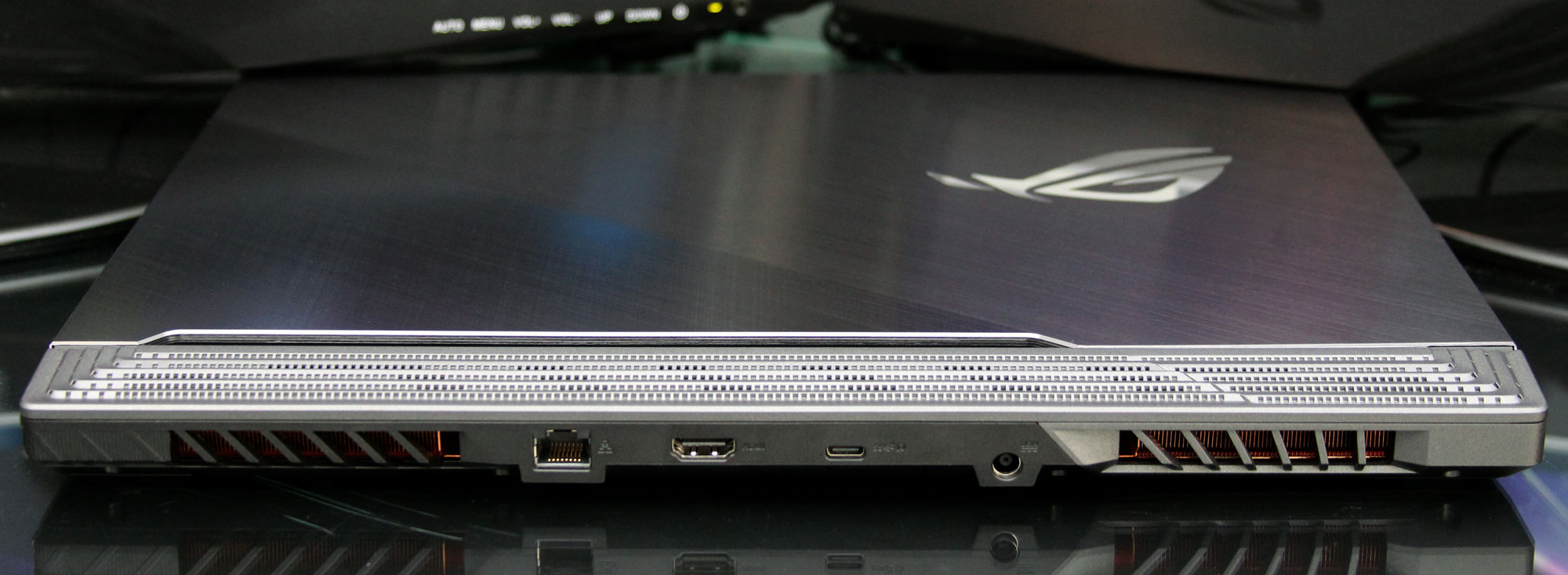
That’s I/O you probably wouldn’t need unless you were docked at home or in the office, hooked up to a local area network and external display. I especially appreciated that our engineers moved those interfaces to the back where they won’t interfere with peripherals on the sides.
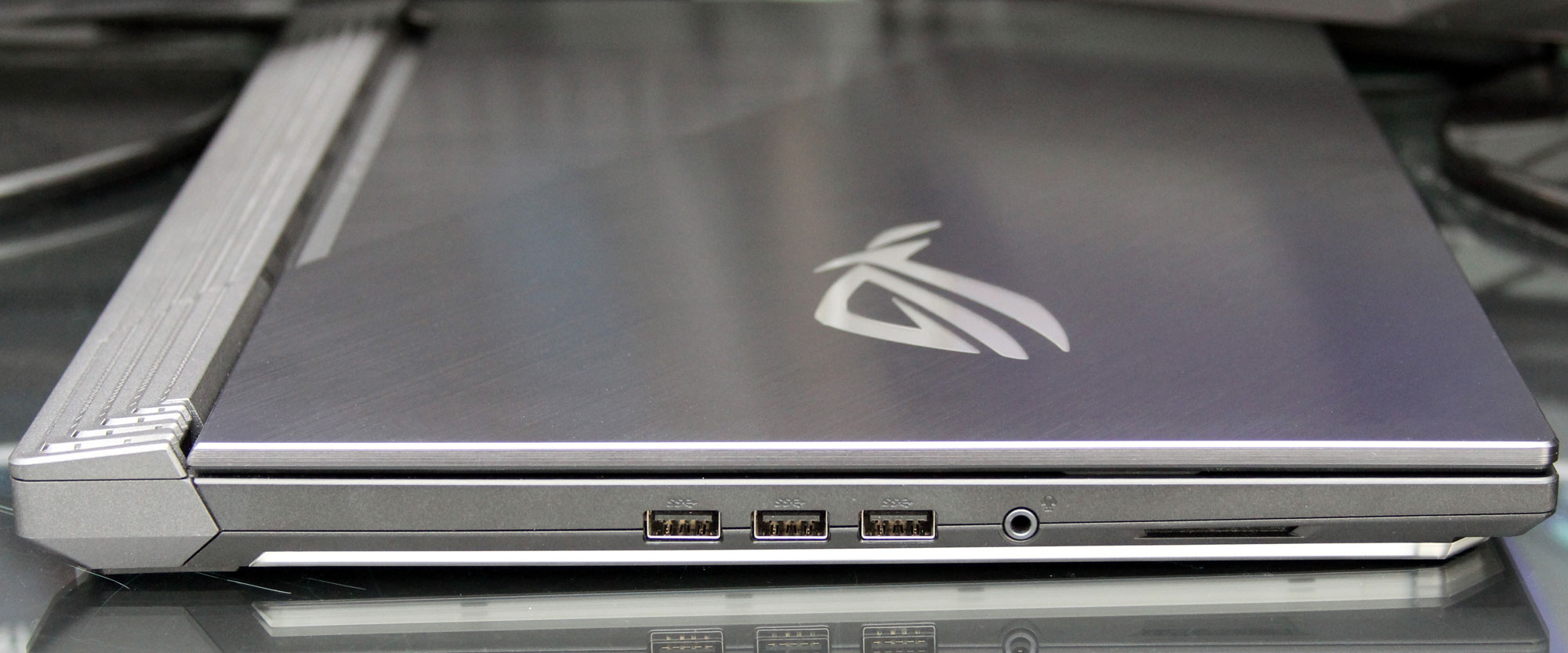
The laptop’s left side becomes an exercise in minimalism as a result. You’ll find three USB 3.1 Gen 1 ports, perfect for thumb drives, a mouse, and maybe your favorite mechanical keyboard, plus a 3.5mm audio jack for a headset. There’s also a small cut-out covered by a grille for sound to escape for when you find yourself listening to music through the Strix SCAR III’s 4W speakers.

This cut-out is mirrored on the other side, in front of the Keystone port. Aside from a third exhaust, those are the only features along the laptop’s right edge. It’s a clean design, to be sure.
The sound of victory
The SCAR III gives you a couple of different options for interacting with teammates. First, we built in a pair of side-firing speakers protected by Smart Amp technology, which keeps the drivers within their thermal and excursion limits. Real-time adjustments help minimize distortion, improve dynamic range, and amplify bass levels. I played several different genres of music through the speakers and never got them to buckle, even through bass-heavy EDM passages. Gaming was no problem at all. The SCAR III faithfully reproduced the rumble of explosions and the staccato of gunshots.
A microphone array built into the bottom bezel of the display is ready for voice chat right out of the box. If you’re home alone and can’t be bothered to dig up a headset, the Strix SCAR III is ready to capture your orders to your team and your shouts of victory or defeat. Most gamers will probably want to plug in their favorite headphones and mic, though. I connected a gaming headset to one of the USB ports and then tried a set of professional DJ headphones in the 3.5mm audio jack. Music, games, and movies sounded great through both setups.
Lightning-fast input for competitive gaming
We all know that potent hardware specifications are imperative for competitive gaming on the road. If your laptop can’t muster high enough frame rates, then you’re already at a disadvantage. But you also need input devices up to the task.
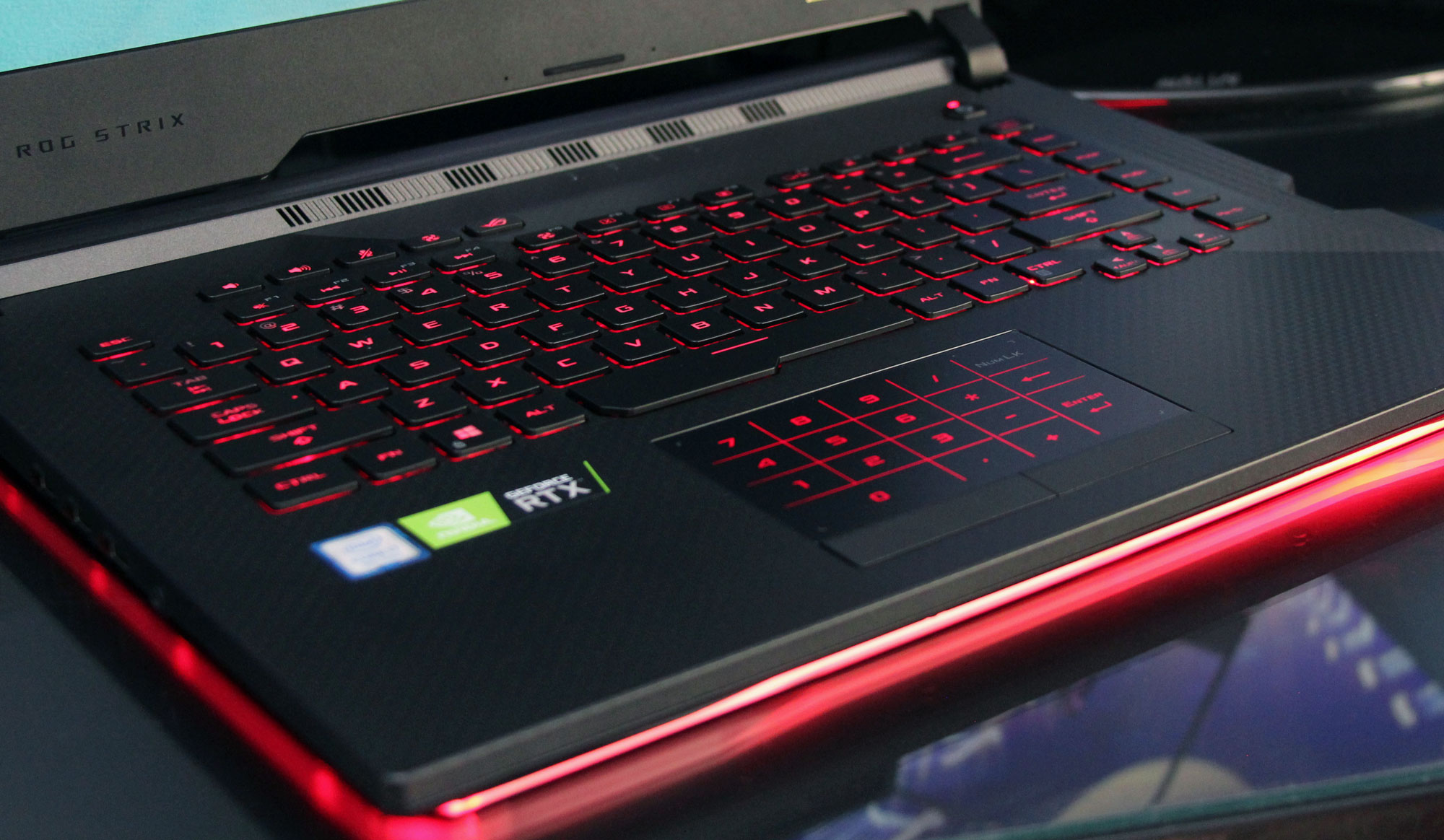
By day, the 15” G531GW’s keyboard and trackpad work well for basic productivity—browsing the web, knocking out emails, or keeping those spreadsheets up to date. There’s even a number lock function built into the trackpad’s upper-right corner. Press it for more than one second, and the pad lights up with all the keys you’d expect from a full-size keyboard’s number pad. Press it again to switch back.
You’ll obviously want to carry your own mouse around for gaming, though. Because the laptop’s keyboard is set back in the chassis with its touchpad up front, I hit Fn+F10 to disable the touchpad any time I wanted to game. If you spring for an Aura-capable mouse, you can tie it into the SCAR III’s lighting scheme. Go ahead and plug in a USB-powered headset, too; there’s still plenty of connectivity on this laptop’s left side for gaming-oriented peripherals.
USB keyboards are a little trickier to tote around, so it was important to arm the SCAR III with something that’d serve hardcore gamers. Overstroke technology registers keypresses with less actuation distance for quicker response to input, while N-key rollover ensures that multi-key combos are never missed. We rate each key for more than 20 million presses to ensure you don’t wear out difficult-to-replace components mid-season.I found that the subtle curve in each cap encouraged me to keep my fingers centered over the keys without needing to look down. And in games like World of Warcraft, where I sometimes need to reach farther than my fingers can stretch, it was easy to set up RGB backlighting to make certain keys stand out for quick contact.
We scattered shortcut keys around the keyboard to make common tasks more accessible. For instance, the up and down arrow keys also serve to amplify or mute the backlight’s intensity. The left and right arrows toggle through available Aura modes. A set of five keys along the top manipulate Windows’ volume control, mute your mic, toggle between performance profiles, and launch straight into the Armoury Crate software. Under them, the F1 through F12 keys perform secondary functions like navigating multimedia files, entering sleep mode, and switching to airplane mode.
The power to game like a pro almost anywhere
It’s rare that I get to test a laptop with more performance potential than most desktop PCs. But the SCAR III's optional 240Hz IPS panel makes gaming action look smoother than anything I've ever seen, and it begs for the long list of high-end hardware I found in my G531GW model. A Core i7-9750H six-core CPU isn’t even the fastest configuration that we offer in this machine, and it effortlessly blew through my battery of gaming benchmarks on the back of NVIDIA’s advanced GeForce RTX 2070 graphics processor.
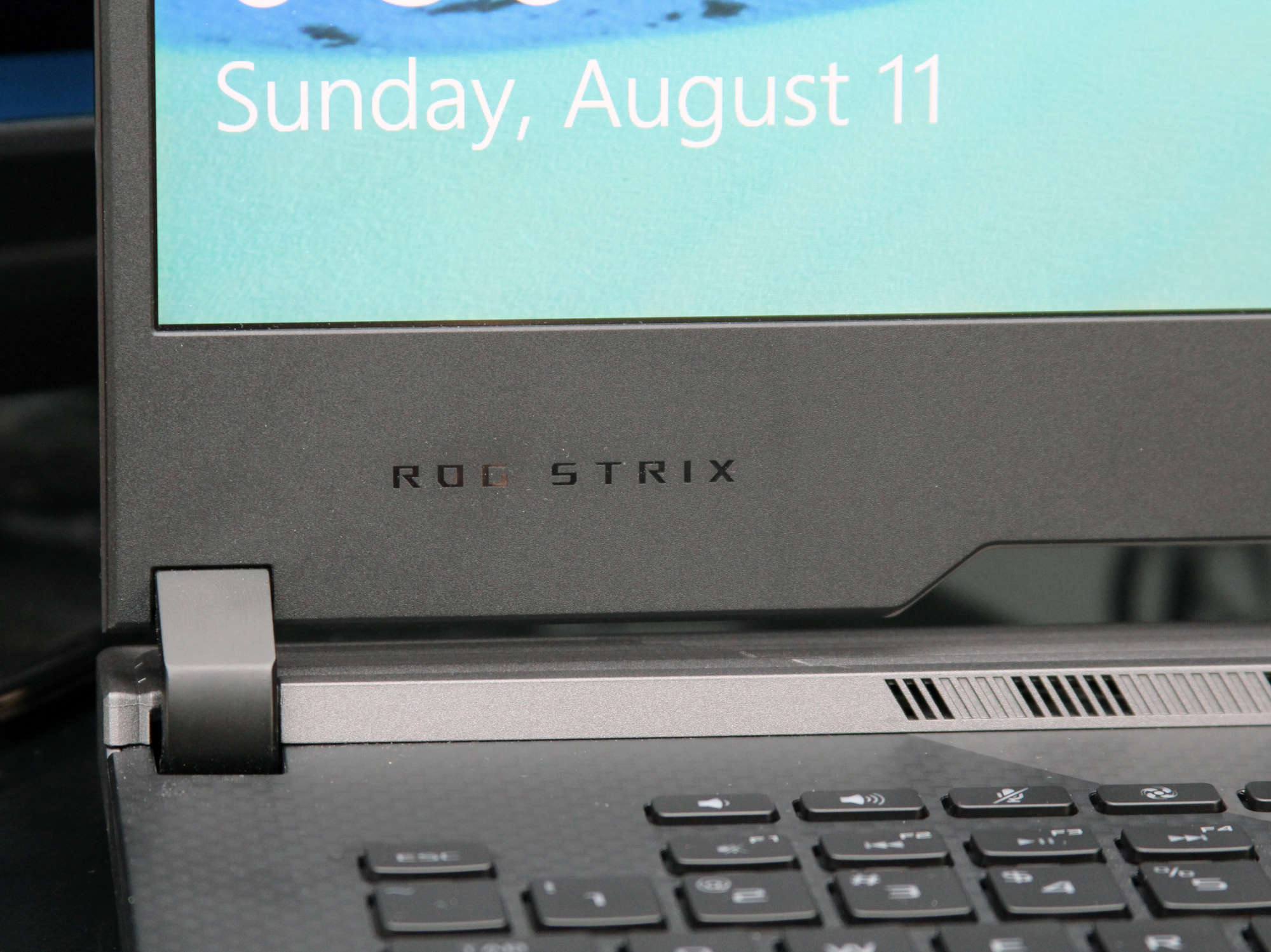
Up to 32GB of DDR4 memory is great for heavy multitasking, and 1TB of NVMe-attached solid-state storage leaves lots of room for all your favorite apps. If that’s not enough capacity, take advantage of the SCAR III’s removable bottom panel and add a SATA drive. Wireless networking with gigabit-class performance potential opens up plenty of bandwidth for streaming to Twitch or downloading multi-gigabyte game patches quickly.
If you’re a competitive gamer, all that pro-level hardware adds up to the extra-fluid frame rates and low response times you need to best your opponents. Enthusiasts who enjoy playing the latest AAA titles can switch on real-time ray tracing, crank the quality slider up to max, and bask in the very best PC gaming has to offer. The Strix SCAR III is even a perfect platform for virtual reality, thanks to its beefy specs and copious connectivity.
Just be ready to turn heads with your SCAR III. I found that its RGB light bar is a real attention-getter. The illuminated logo on the lid stands out, too. And the per-key lighting, configurable on a per-game basis, is both functional and attractive. Best of all, once you get your ROG Strix SCAR III tuned to perfection, it's easy to save all those settings to Armoury Crate via Scenario Profiles so that the SCAR III adapts to whatever you want to do with it.
Check with your local ROG representative for details about Strix SCAR III availability, configurations, and pricing in your region.
by Paul Cross
